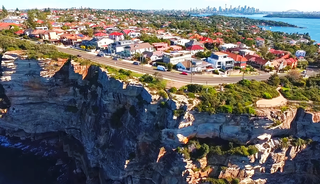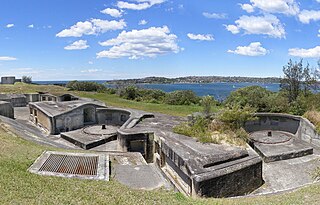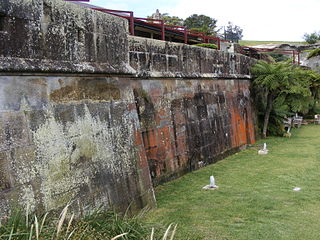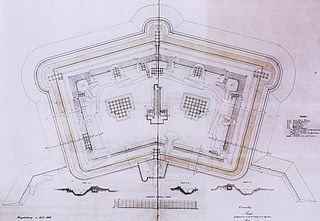

Beehive Casemate is a historical fortification located on the banks of Obelisk Bay, in Sydney Harbour, New South Wales, Australia. It is part of the Sydney Harbour National Park.


Beehive Casemate is a historical fortification located on the banks of Obelisk Bay, in Sydney Harbour, New South Wales, Australia. It is part of the Sydney Harbour National Park.
Construction of the casement began in 1871 and was completed in 1874. The fort was constructed under the supervision of colonial architect James Barnet. The underground casemate was one of the first to be locally designed and built after the withdrawal of British troops in 1870 and the Cardwell Reforms. The fortification contains three domed chambers that were used as gun emplacements. Each chamber had a small opening or window for the gun to fire through with each window looking out towards the Sydney Heads. The underground chambers were made of brick and mortar and were built into the excavated cavities in the sandstone bedrock. They were intended to fire on enemy ships as they navigated the passages around Sow and Pigs Reef, within the entrance to Sydney Harbour. [1] [2]


The Western Heights of Dover are one of the most impressive fortifications in Britain. They comprise a series of forts, strong points and ditches, designed to protect the country from invasion. They were created in the 18th and 19th centuries to augment the existing defences and protect the key port of Dover from both seaward and landward attack; by the start of the 20th century Dover Western Heights was collectively reputed to be the 'strongest and most elaborate' fortification in the country. The Army finally withdrew from the Heights in 1956–61; they are now a local nature reserve.

A casemate is a fortified gun emplacement or armored structure from which guns are fired, in a fortification, warship, or armoured fighting vehicle.

Vaucluse is an eastern suburb of Sydney, in the state of New South Wales, Australia. It is located 8 kilometres (5 mi) east of the Sydney central business district, in the local government areas of Waverley Council and the Municipality of Woollahra.


The Balmain Reservoir is a 2,376,000-imperial-gallon (10.80 ML) disused, covered reservoir located under Gladstone Park in Balmain, in the Inner West of Sydney, New South Wales, Australia.

Sydney Harbour was protected by coastal batteries and other fixed defences from the early 19th century until the 1960s. These defences were constructed to protect the Australian city of Sydney from attack by enemy warships and submarines.

Fort Pasir Panjang or Labrador Battery is located within Labrador Park at the southern tip of Singapore island. It was one of the 11 coastal artillery forts built by the British in the 19th century to defend the western passageway into Keppel Harbour against piracy and foreign naval powers. During the 1942 Battle of Pasir Panjang, the fort played a supporting role but a limited one in defending the Malay Regiments against the Japanese invasion at Bukit Chandu. In 1995, the site was gazetted by the National Heritage Board as one of the 11 World War II sites in Singapore.

The Middle Head Fortifications is a heritage-listed former defence establishment and military fortifications and now public space located at Middle Head Road, Middle Head, Mosman in the Mosman Council local government area of New South Wales, Australia. It is also known as the Middle Head Military Fortifications or The Old Fort. The fortifications consist of the Outer Middle Head Battery located at the end of Old Fort Road, the Inner Middle Head Battery located at the end of Governors Road, and the Obelisk batteries reached by a path from the corner of Middle Head Road and Chowder Bay Road. The fortifications at Middle Head formed part of Sydney Harbour's defences. The property is owned by the NSW Office of Environment and Heritage. It was added to the New South Wales State Heritage Register on 2 April 1999.


The Georges Head Battery, also called the Georges Head Military Fortifications, is a heritage-listed former military fortification located on the Georges Head on Chowder Bay Road, Georges Heights, New South Wales, Australia.

The Hobart coastal defences are a network of now defunct coastal batteries, some of which are inter-linked with tunnels, that were designed and built by British colonial authorities in the nineteenth century to protect the city of Hobart, Tasmania, from attack by enemy warships. During the nineteenth century, the port of Hobart Town was a vital re-supply stop for international shipping and trade, and therefore a major freight hub for the British Empire. As such, it was considered vital that the colony be protected. In all, between 1804 and 1942 there were 12 permanent defensive positions constructed in the Hobart region.

The Steele Point Battery is a small fort, on the shores of Port Jackson in the eastern Sydney suburb of Vaucluse, Australia.

The Bradleys Head Fortification Complex is a heritage-listed former mast and defensive battery and military fortification and now war memorial and recreational area located at Bradleys Head Road within the Sydney Harbour National Park in Mosman in the Mosman Council local government area of New South Wales, Australia. It was designed by Government engineers and built from 1840 to 1934. It is also known as Bradleys Head Forts and HMAS Sydney 1 Mast and Associated Memorials. The property is owned by the NSW Office of Environment and Heritage, an agency of the Government of New South Wales. It was added to the New South Wales State Heritage Register on 30 August 2010.

Fort Banks is an old World War II bunker and fortification complex that was used to protect the approaches to Botany Bay. The fortification is located north of Cape Banks in La Perouse, New South Wales, Australia.

The Dawes Point Battery remains is a heritage-listed former artillery fortification and now visitor attraction located adjacent to the southern pylon of the Sydney Harbour Bridge at Hickson Road in inner city Sydney, on the boundary between Dawes Point and The Rocks in the City of Sydney local government area of New South Wales, Australia. It was built and modified from 1791 to 1925 by Lieutenant William Dawes, Robert Ross, Francis Greenway, and George Barney. The property is owned by Property NSW, an agency of the Government of New South Wales. It was added to the New South Wales State Heritage Register on 10 May 2002.


Mosman is a suburb on the Lower North Shore region of Sydney, in the state of New South Wales, Australia. Mosman is located 8 kilometres north-east of the Sydney central business district and is the administrative centre for the local government area of the Municipality of Mosman.

Lascaris Battery, also known as Fort Lascaris or Lascaris Bastion, is an artillery battery located on the east side of Valletta, Malta. The battery was built by the British in 1854, and it is connected to the earlier St. Peter & Paul Bastion of the Valletta Land Front. In World War II, the Lascaris War Rooms were dug close to the battery, and they served as Britain's secret headquarters for the defence of the island.

Point Battery is a former gun emplacement on Portsmouth Point in Hampshire. Part of the fortifications of Portsmouth, it was built alongside an earlier defensive structure to help defend Portsmouth Harbour in the event of an attack. Fort Blockhouse on the other side of the harbour entrance was rebuilt at around the same time as part of the same scheme. In the mid-19th century the battery was enlarged and Point Barracks were built alongside, to house the artillery troops responsible for manning the defences.

A polygonal fort is a type of fortification originating in France in the late 18th century and fully developed in Germany in the first half of the 19th century. Unlike earlier forts, polygonal forts had no bastions, which had proved to be vulnerable. As part of ring fortresses, polygonal forts were generally arranged in a ring around the place they were intended to protect, so that each fort could support its neighbours. The concept of the polygonal fort proved to be adaptable to improvements in the artillery which might be used against them, and they continued to be built and rebuilt well into the 20th century.